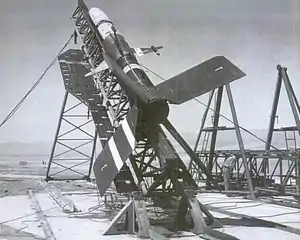AAM-N-5 Meteor
The AAM-N-5 Meteor was an early American air-to-air missile, developed by the Massachusetts Institute of Technology and Bell Aircraft for the United States Navy. Designed for launch from carrier-based aircraft, the program proceeded to the flight testing stage before being cancelled.
| AAM-N-5 Meteor | |
|---|---|
 | |
| Type | Air-to-air missile |
| Place of origin | United States |
| Service history | |
| In service | 1948-1953 |
| Used by | United States Navy |
| Production history | |
| Designer | Massachusetts Institute of Technology |
| Designed | 1945-1946 |
| Manufacturer | Bell Aircraft |
| Specifications | |
| Mass | 580 pounds (260 kg) |
| Length | 13 feet 11.25 inches (4.25 m) |
| length | 9 feet 6 inches (2.90 m) w/out booster |
| Diameter | 8.9 inches (230 mm) |
| Warhead | High explosive |
| Warhead weight | 25 pounds (11 kg) |
| Engine | Liquid-fuel rocket Booster: Solid-fuel rocket |
| Wingspan | 3 ft 2.8 in (0.986 m) |
Operational range | 25 miles (40 km) |
| Flight altitude | Max at launch, 10 miles (16 km) |
| Maximum speed | Mach 2+ |
Guidance system | Semi-active radar homing |
Development
Development of the Meteor was loosely defined at first, with both surface-to-air and air-to-air missiles being studied by the Massachusetts Institute of Technology under a contract awarded in November 1945 by the U.S. Navy's Bureau of Ordnance; the decision was made to construct the air-to-air version for testing, with construction of the airframe being assigned to Bell Aircraft.[1][2]
As built, the AAM-N-5 Meteor was a two-stage missile, utilizing semi-active radar homing;[2] the first stage consisted of a solid-fueled rocket booster, with the main sustainer stage utilizing liquid fuels.[3] It had a range of 25 miles (40 km), and reached speeds of over Mach 2,[1] with some sources claiming a top speed of Mach 3.[4] Control was provided by cruciform fins.[5]
Flight testing of the AAM-N-5 began in July 1948 at the Naval Ordnance Test Station,[2] with Douglas JD-1 Invader utility aircraft acting as the launching platform. Starting in 1951, test launches were conducted using Douglas F3D Skyknight nightfighters as carrier aircraft;[1] fifteen launches were also made from ground launchers at NOTS' China Lake range.[3] However, in 1953 the program was cancelled, as better missiles were becoming available.[1]
An advanced version of Meteor, Meteor II, was assigned to be built by United Aircraft; it was intended to have a solid-fueled booster rocket with a ramjet sustainer stage, but was not built.[3]
References
Citations
- Parsch 2003
- Friedman 1982, p.275.
- Babcock 2008, p.20-21.
- "Aircraft Armament, Part 2: Missiles and Projectiles". Flight International, 28 January 1955, p.118.
- Ordway and Wakeford 1960, p.187.
Bibliography
- Babcock, Elizabeth (2008). Magnificent Mavericks: transition of the Naval Ordnance Test Station from rocket station to research, development, test and evaluation center, 1948-58. History of the Navy at China Lake, California. 3. Washington, DC: Government Printing Office. ISBN 978-0945274568.
- Friedman, Norman (1982). U.S. Naval Weapons: every gun, missile, mine, and torpedo used by the U.S. Navy from 1883 to the present day. Annapolis, MD: Naval Institute Press. ISBN 978-0-87021-735-7.
- Ordway, Frederick Ira; Ronald C. Wakeford (1960). International Missile and Spacecraft Guide. New York: McGraw-Hill. ASIN B000MAEGVC.
- Parsch, Andreas (2003). "MIT/Bell AAM-N-5 Meteor". Directory of U.S. Military Rockets and Missiles Appendix 1: Early Missiles and Drones. designation-systems.net. Retrieved 21 January 2013.